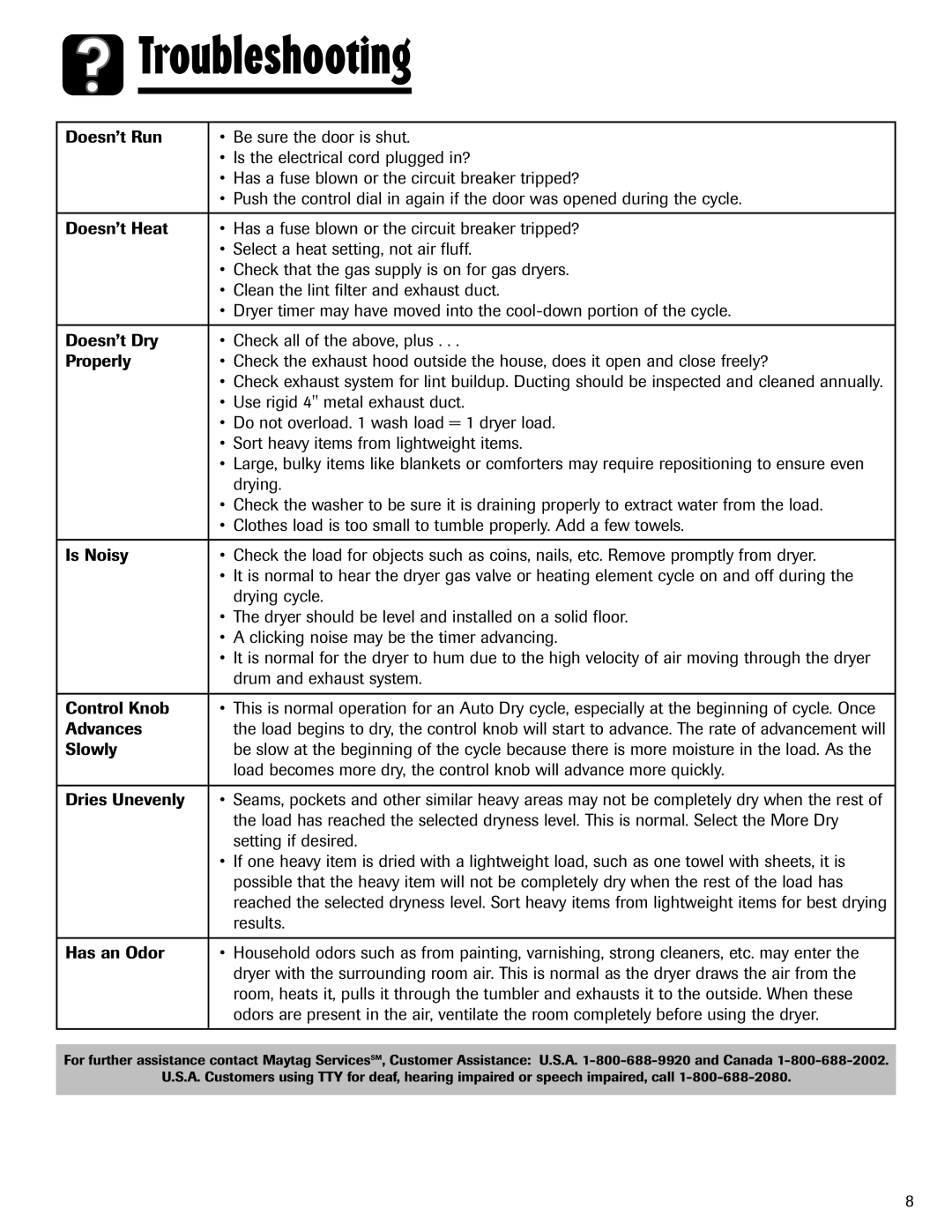


 Troubleshooting
Troubleshooting
Doesn’t Run | • | Be sure the door is shut. |
| • | Is the electrical cord plugged in? |
| • Has a fuse blown or the circuit breaker tripped? | |
| • Push the control dial in again if the door was opened during the cycle. | |
|
| |
Doesn’t Heat | • Has a fuse blown or the circuit breaker tripped? | |
| • | Select a heat setting, not air fluff. |
| • Check that the gas supply is on for gas dryers. | |
| • | Clean the lint filter and exhaust duct. |
| • Dryer timer may have moved into the | |
|
|
|
Doesn’t Dry | • | Check all of the above, plus . . . |
Properly | • Check the exhaust hood outside the house, does it open and close freely? | |
| • Check exhaust system for lint buildup. Ducting should be inspected and cleaned annually. | |
| • | Use rigid 4" metal exhaust duct. |
| • Do not overload. 1 wash load = 1 dryer load. | |
| • | Sort heavy items from lightweight items. |
| • Large, bulky items like blankets or comforters may require repositioning to ensure even | |
|
| drying. |
| • | Check the washer to be sure it is draining properly to extract water from the load. |
| • Clothes load is too small to tumble properly. Add a few towels. | |
|
| |
Is Noisy | • Check the load for objects such as coins, nails, etc. Remove promptly from dryer. | |
| • It is normal to hear the dryer gas valve or heating element cycle on and off during the | |
|
| drying cycle. |
| • | The dryer should be level and installed on a solid floor. |
| • A clicking noise may be the timer advancing. | |
| • | It is normal for the dryer to hum due to the high velocity of air moving through the dryer |
|
| drum and exhaust system. |
|
|
|
Control Knob | • | This is normal operation for an Auto Dry cycle, especially at the beginning of cycle. Once |
Advances |
| the load begins to dry, the control knob will start to advance. The rate of advancement will |
Slowly |
| be slow at the beginning of the cycle because there is more moisture in the load. As the |
|
| load becomes more dry, the control knob will advance more quickly. |
|
| |
Dries Unevenly | • Seams, pockets and other similar heavy areas may not be completely dry when the rest of | |
|
| the load has reached the selected dryness level. This is normal. Select the More Dry |
|
| setting if desired. |
| • | If one heavy item is dried with a lightweight load, such as one towel with sheets, it is |
|
| possible that the heavy item will not be completely dry when the rest of the load has |
|
| reached the selected dryness level. Sort heavy items from lightweight items for best drying |
|
| results. |
|
| |
Has an Odor | • Household odors such as from painting, varnishing, strong cleaners, etc. may enter the | |
|
| dryer with the surrounding room air. This is normal as the dryer draws the air from the |
|
| room, heats it, pulls it through the tumbler and exhausts it to the outside. When these |
|
| odors are present in the air, ventilate the room completely before using the dryer. |
|
|
|
For further assistance contact Maytag ServicesSM, Customer Assistance: U.S.A.
U.S.A. Customers using TTY for deaf, hearing impaired or speech impaired, call
8
